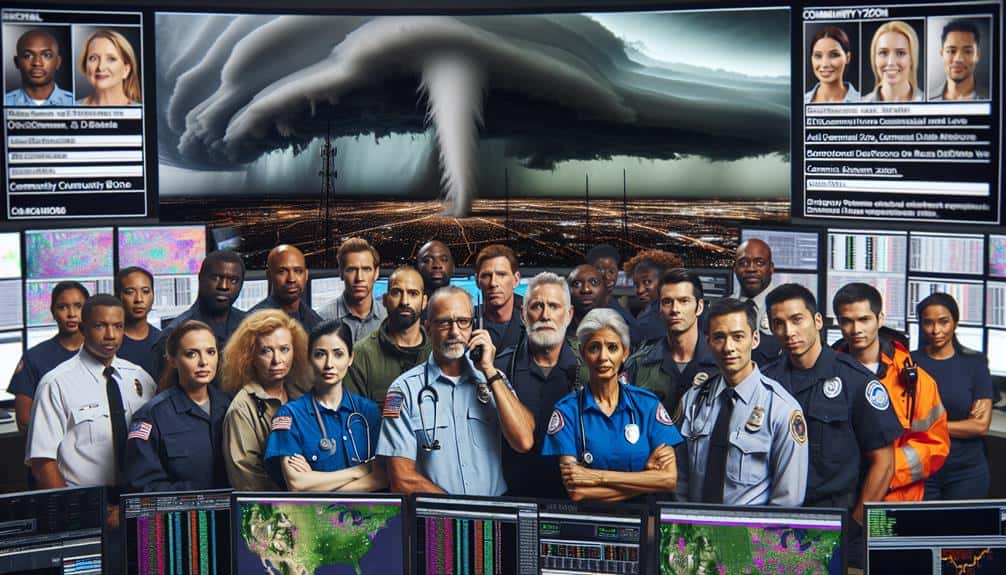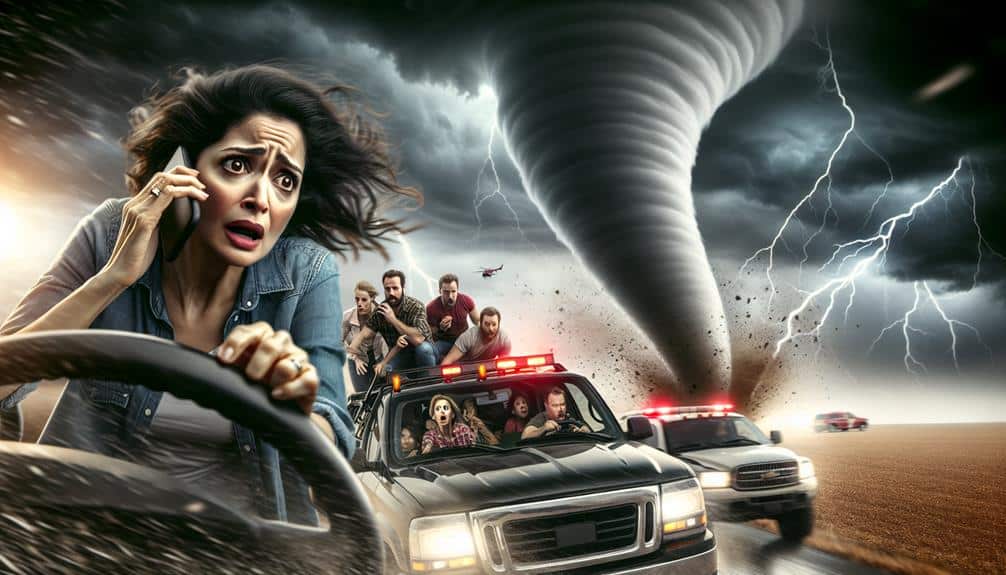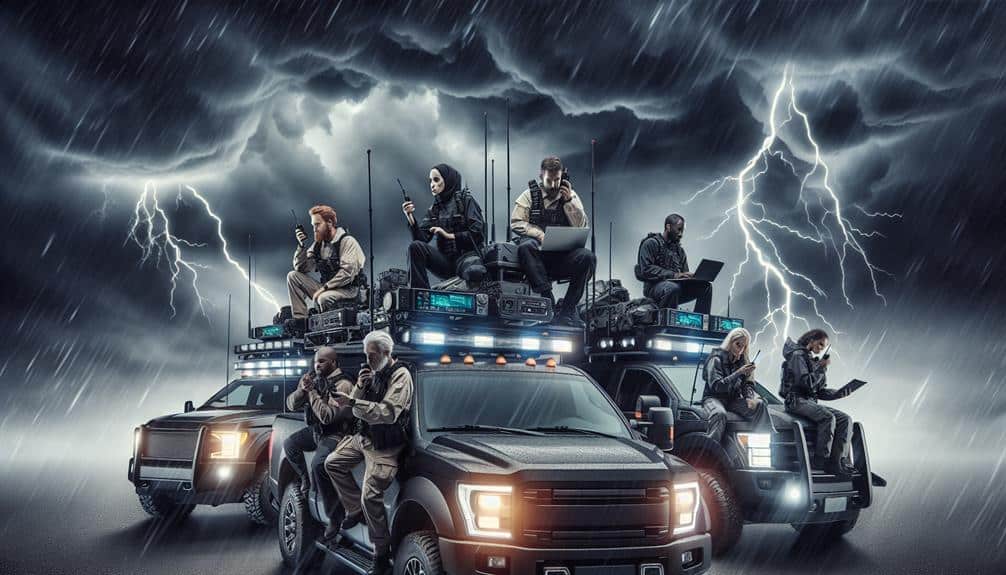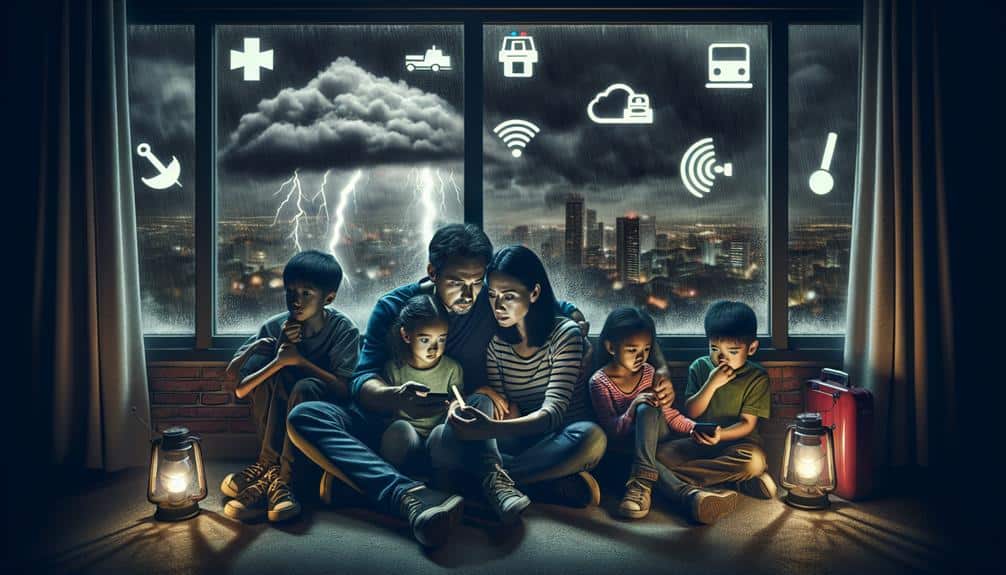We coordinate with emergency dispatch during storm incidents because it greatly improves our safety protocols by making sure all responders are well-trained and can use emergency equipment effectively. Real-time information sharing allows us to provide timely updates and make well-informed decisions. Strategic planning with dispatch helps us allocate resources efficiently and maintain operational readiness, minimizing response times. Additionally, understanding and addressing the specific needs of our community strengthens disaster preparedness and resilience. By working closely with dispatch, we guarantee a thorough and efficient response to any storm-related emergencies, helping us achieve even better outcomes.
Key Points
- Ensures accurate and timely information sharing, which is crucial for effective storm response.
- Enhances resource allocation by coordinating the deployment of emergency personnel and equipment.
- Improves community safety with streamlined evacuation and emergency procedures.
- Reduces response time through efficient communication and real-time updates.
Enhancing Safety Measures
How can we strengthen our safety measures to guarantee better coordination with emergency dispatch during storm incidents?
First, we need to implement thorough training programs. These programs should equip our teams with the skills necessary to handle storm-related emergencies effectively. By simulating real-life scenarios, we make certain everyone knows their role and can perform under pressure. Training can include everything from safe evacuation procedures to the proper use of emergency equipment.
Next, we must establish robust communication protocols. Clear and efficient communication is the backbone of any emergency response. We should develop standardized communication procedures that detail how information flows between field teams and emergency dispatch. This includes designating specific channels for different types of information and ensuring all personnel are familiar with these channels.
Additionally, periodic drills can help us test both our training programs and communication protocols. These drills will highlight any weaknesses in our current systems and provide an opportunity to make necessary adjustments. By focusing on these areas, we not only enhance our safety measures but also guarantee our coordination with emergency dispatch is seamless and effective.
This approach empowers us to handle storm incidents with confidence and precision, safeguarding both lives and property.
Real-Time Information Sharing
To improve our response capabilities, we must prioritize real-time information sharing between field teams and emergency dispatch. When data accuracy is crucial, timely updates from the field empower dispatchers to make informed decisions quickly. We can't afford delays or misinformation during a storm incident. Real-time data guarantees that our actions are based on the most current conditions, minimizing risks and maximizing efficiency.
Communication effectiveness is central to this process. Field teams equipped with reliable communication tools can relay critical information about road conditions, power outages, and emergent threats directly to dispatch. This two-way communication allows dispatch to provide immediate, precise instructions, helping us adapt to rapidly changing situations. The result? Swift, coordinated responses that protect lives and property.
Moreover, when we share real-time information, we foster a sense of unity and purpose. Everyone knows their role and has the latest data to execute it effectively. This alignment not only boosts our operational efficiency but also instills confidence in our teams and the communities we serve.
Accurate, effective communication isn't just a strategy; it's a requirement for successful storm incident management. Let's leverage real-time information sharing to elevate our response capabilities.
Efficient Resource Allocation
Efficient resource allocation is vital during storm incidents to guarantee that our teams and equipment are deployed where they're needed most. By coordinating with emergency dispatch, we make sure that we're not just reacting impulsively but engaging in strategic planning. This approach allows us to maximize cost effectiveness, utilizing our resources wisely without unnecessary expenditure.
When a storm hits, every second counts. Knowing exactly where to send personnel and equipment can make a significant difference. By having a clear, coordinated plan, we avoid the pitfalls of over-deployment in one area and under-deployment in another. This balance is essential for maintaining operational efficiency and making sure that no part of the affected area is left unsupported.
Moreover, strategic planning facilitated by emergency dispatch helps us forecast needs more accurately. We can pre-position resources based on predictive models and real-time data, enhancing our readiness and response capabilities. This not only saves money but also guarantees that our teams are operating at their highest potential, free from the chaos that often accompanies storm incidents.
In essence, efficient resource allocation through coordination with emergency dispatch is a cornerstone of our storm response strategy, ensuring that we act with precision, effectiveness, and cost efficiency.
Minimizing Response Time
By guaranteeing efficient resource allocation, we can now focus on minimizing response time to storm incidents, getting help to those in need faster. Effective time management and quick communication are pivotal in reducing the critical moments between an emergency call and the arrival of assistance.
Here's how we can achieve this:
- Real-time Data Sharing: Sharing up-to-date information between emergency teams allows us to allocate resources where they're needed most and adjust plans on the fly.
- Streamlined Protocols: Establishing clear, concise protocols guarantees everyone knows their roles and responsibilities, reducing confusion and delays.
- Integrated Technology: Utilizing advanced communication systems, such as GPS tracking and mobile apps, helps us coordinate efforts seamlessly and provide real-time updates.
With these measures, we empower our teams to act decisively and efficiently. Quick communication is key in storm incidents, where every second counts. By prioritizing these strategies, we guarantee that our response isn't only fast but also effective, ultimately saving lives and protecting communities. Our commitment to excellence in time management is what sets us apart in emergency response.
Community Impact Awareness

Understanding the significant impact of storm incidents on our community is important for tailoring our emergency response efforts effectively. When we acknowledge the specific challenges and needs our community faces, we can deploy targeted strategies that maximize safety and minimize disruption.
Community engagement plays a pivotal role in enhancing our disaster preparedness. By involving local residents in planning and drills, we ensure that everyone knows their roles and responsibilities during a storm. This not only empowers individuals but also fosters a collective resilience that can withstand the pressures of an emergency.
Public education is another critical component. We must continuously inform our community about the risks associated with storms and the steps they can take to protect themselves and their property. Clear, consistent messaging can make all the difference when a storm hits, as an informed public is more likely to respond calmly and effectively.
Our coordinated emergency response efforts hinge on this awareness. When the community is well-prepared and informed, emergency dispatch can operate more efficiently, knowing that citizens are taking proactive steps to safeguard themselves.
Together, through education and engagement, we can bolster our community's readiness and resilience against storm incidents.
Frequently Asked Questions
What Are the Common Communication Tools Used for Coordinating With Emergency Dispatch?
We use communication methods like radios and reliable technology tools such as GPS for dispatch coordination. These guarantee efficient emergency response. Real-time updates via mobile apps and satellite phones keep us connected and coordinated during crises.
How Can Local Residents Get Involved in Storm Preparedness Initiatives?
We can boost community involvement by promoting volunteer opportunities like neighborhood watch groups, storm awareness workshops, and emergency response training. These initiatives empower residents to take proactive steps, ensuring our community's safety and resilience during storm incidents.
What Training Do Dispatchers Receive for Handling Storm-Related Incidents?
Dispatchers receive extensive training on storm procedures. We focus on real-time communication, resource allocation, and safety protocols. This guarantees we're ready to handle emergencies efficiently, providing the freedom and security our communities need during severe weather events.
Are There Any Apps That Provide Real-Time Updates on Storm Emergencies?
Yes, several emergency response apps provide real-time alerts for storm emergencies. We recommend using apps like FEMA, WeatherBug, and Red Cross Emergency for timely updates and essential safety information, ensuring you stay informed and prepared.
How Do Emergency Dispatch Protocols Differ Between Urban and Rural Areas?
Urban vs. rural protocols are worlds apart! In urban areas, we rely on advanced dispatch communication tools for rapid response. In rural areas, we often use more traditional methods due to limited resources and infrastructure.


